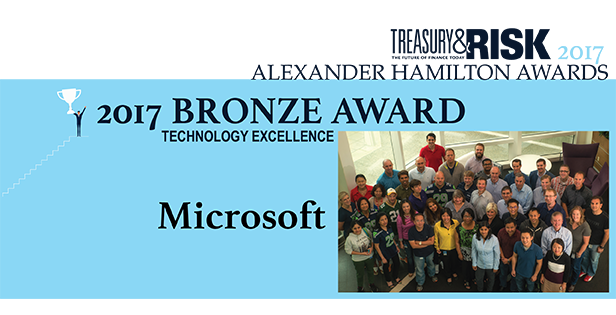
Technology is pervasive in our treasury functions, as in our lives. Few initiatives these days do not have a tech component. And yet some organizations are taking their technology projects above and beyond.
Companies that focus on deploying third-party software can achieve impressive efficiencies. But companies that think outside the box to stretch technologies in new directions stand to reap even greater rewards—a lesson demonstrated by this year's winners of the Alexander Hamilton Awards in Technology Excellence, sponsored by Deutsche Bank, FiREapps, Citi, and Deloitte.
Recommended For You
It should come as no surprise that Microsoft is looking to use technology in innovative ways. And yet this year's winning project stands out.
Instead of running a single treasury management system, Microsoft maintains a diverse treasury infrastructure, with many applications developed in-house. The systems work well, but managing them on-premises was becoming unwieldy, and the treasury team saw an opportunity to improve efficiency by moving them to the cloud. "Since the hardware had to be provisioned to accommodate the peaks in traffic so that everything ran properly at month-end, quarter-end, and year-end, the hardware was sitting cold for the other 29 days in the month," says Pankaj Gudimella, treasury director. "That's capex that was not being utilized."
The project was complex and challenging, but the Microsoft treasury team pulled it off, and the results have been well worth the effort. In addition to the efficiency improvements, the treasury team have boosted their agility, and the IT team now has more time to support strategic initiatives. "They're spending less of their time on maintenance activities, and more time doing cool new stuff to make our lives better," says George Zinn, corporate VP and treasurer.
At Toyota Financial Services, a culture of continuous improvement often guides new initiatives, and a project to streamline payment processing for its 4.6 million customers was no exception. "We wanted to provide an omni-channel approach to payments that included mobile technology," explains Lakshan Fernando, cash and liquidity projects manager.
The company redesigned its Web and mobile payment channels to have the same look and feel, and tied both in with its customer account management system. The shift reduced payment processing costs and reduced the call volume to the company's payment customer service center.
This year's final winner in the Technology Excellence category may come as a bit of a surprise: It's the U.S. Department of the Treasury's Bureau of the Fiscal Service, a federal agency that helps other branches of the federal government collect around $4 trillion in revenue annually.
In 2012, the bureau's Revenue Collections Management group was looking for a mobile payment technology. Rather than seek a solution to purchase, assistant commissioner Corvelli McDaniel spearheaded the creation of an R&D Incubator Lab. The lab recruited internal employees to participate, then encouraged them to work with private-sector participants to generate ideas and sell those ideas to executives through a selection process based on the TV show Shark Tank. The first year's lab was so successful that the agency has continued to host R&D Incubator Labs once or twice a year ever since.
The lab "has given employees confidence to take more license to recommend different alternatives," says McDaniel. "They see that when you unleash new ideas and new technologies, something exciting could happen."
In each of our three winners, something exciting has indeed happened.
Taming the Hydra of Treasury's IT Needs
Microsoft has an innovative treasury function that eschews a generalized treasury management system in favor of best-in-class line-of-business applications and data visualization solutions. A couple of years ago, efficiency was a challenge for managers of the treasury technology infrastructure.
"If you're a retail website, you have to be prepared to deal with Black Friday from a volume-of-transactions perspective. If you're a corporate treasury, you have to be prepared to deal with quarter-ends," explains George Zinn, corporate VP and treasurer of Microsoft. "In our past environment, we needed to provision a lot of hardware with enough capacity to handle our busiest days."
"Since the hardware had to be provisioned to accommodate the peaks in traffic so that everything ran properly at month-end, quarter-end, and year-end, the hardware was sitting cold for the other 29 days in the month," says Pankaj Gudimella, treasury director for Microsoft. "That's capex that was not being utilized."
Another challenge in that environment was the difficulty of maintenance and routine updates to the diverse systems. "Our change-request queue was like the Hydra," Zinn says. "Our IT partners would no sooner begin an urgent request in the prioritized queue, than two more would rear their ugly heads. We'd just want to make a small change to a report, like adding a column or a field, and our IT group would have to do a lot of coding to make that happen. Maintenance of the systems was consuming far too much IT time."
 The treasury team realized they could leverage Azure, Microsoft's cloud computing platform and services, to streamline their own technology infrastructure. They began planning to move their 24 internally developed treasury applications—including tools for cash forecasting, cash visibility, bank account management, and loan management—from on-premises servers into the Azure cloud.
The treasury team realized they could leverage Azure, Microsoft's cloud computing platform and services, to streamline their own technology infrastructure. They began planning to move their 24 internally developed treasury applications—including tools for cash forecasting, cash visibility, bank account management, and loan management—from on-premises servers into the Azure cloud.
Business leaders within treasury teamed up with the treasury IT group and the Azure engineering team to determine which applications should move when. They ranked every application on its importance to the organization, its impact on other areas of treasury, the size of its user base, and the cost and ease of migration, both for IT and for end users.
The easiest to migrate went first. For each application, the migration team provisioned and configured the necessary Azure infrastructure, which consisted mostly of virtual machines and virtual networking components. Then, once the infrastructure was configured, they began shifting the system to the cloud. "We ran each application in parallel for a period of time, in both the legacy, on-premises environment and the virtual Azure databases," Gudimella says. "We had a very good rollback plan, just in case. And we built a feedback loop to incorporate what we learned from one round of migrations into the next round."
Overall, it was a very smooth transition. "We did a 'lift and shift,'" Gudimella explains. "Some end users participated in a 'smoke test' to make sure all the connections were working, the database was working, the reports were running properly, etc. But for the most part, our business users did not even know a change had happened on the back end."
Now Microsoft treasury is in phase two of the transition, which involves moving the internally developed applications to platform-as-a-service/software-as-a-service to take full advantage of the Azure environment. "When we started looking at reworking our processes and the workflows surrounding our treasury applications," Zinn explains, "we could see a great opportunity to improve efficiency if we modified the software to be more integrated in terms of working with Azure and taking advantage of the processing capabilities inherent in Azure services."
The software upgrades are guided by the goal of using the elasticity and scalability of the Azure platform to consolidate Microsoft's treasury data, reduce data silos, provide business insights using data updated in real time, and utilize the built-in resiliency of the Azure architecture whenever possible.
"We're going up the stack, moving from infrastructure-as-a-service to software-as-a-service," Gudimella reports. "We're looking to significantly improve the user interface and user experience of our first-party treasury applications." They're also improving "telemetry"—in other words, the ability of the IT team to proactively monitor treasury systems.
Although the transition continues, many of its benefits are already manifest. The footprint of the treasury team's IT infrastructure is 61 percent smaller than in its legacy environment, and its costs are down 20 percent year-over-year. "We get charged the same way other Microsoft customers get charged," Zinn says. "On days where we're not consuming a lot, we are not paying for a huge infrastructure footprint and having to maintain it. That's what has created the dramatic cost savings."
Microsoft treasury has also gained agility. "Before, when we would start a project, we would go to the IT team, ask them to provision some hardware, and then wait for a few weeks or a month," Gudimella says. "Now we can spin up those machines within minutes, start working on our project, and wind them down ourselves when the time comes."
This frees up time within the IT group to contribute more to the strategic direction of the organization. "They're spending less of their time on the maintenance activities required to keep the lights on, and more time doing cool new stuff to make our lives better," Zinn says. "The business teams now have more time to look at things like business intelligence and analytics capabilities, machine learning for our forecasts, and blockchain-as-a-service.
"The other beautiful thing is that the business side feels a lot more empowered now," Zinn concludes. "These hosted applications enable our analysts to create reports and dashboards without having any coding expertise. And then everyone from the executive suite on down can access the dashboards themselves. Having self-serve treasury data helps everyone throughout the treasury function spend more time on activities that are strategic. This is the democratization of business intelligence and advanced analytics."
Streamlining Payments for Customers
The captive finance arm of Toyota Motor Corp., Toyota Financial Services (TFS) collects around 55 million payments annually from 4.6 million auto retail (loan) and lease customers. Due to the volume of payments processed, and in light of the trend toward online and mobile payments, TFS needed to reengineer its electronic billing and payments platform.
"We needed a billing and payments system to provide an enhanced customer experience," says Lakshan Fernando, cash and liquidity projects manager for TFS. "We wanted to provide an omni-channel approach to payments that included mobile technology. And there were several new features we wanted to offer our customers, such as SMS payment notification, options for setting up recurring payments, and better visibility into payment status."
TFS established a billing and payments working group that included representatives from treasury, service operations, business technology solutions, strategic planning, digital marketing, legal, and compliance. This collaborative approach ensured that multiple goals, objectives, and areas of concern were addressed. This dialogue was crucial, Fernando says, because "a nice-to-have feature for one department might have a negative impact on another."
The working group settled on a list of objectives for the initiative; the goals revolved around customer service and cost savings. TFS leveraged the "Toyota Way" corporate philosophy of continuous improvement, better known as kaizen, to update its legacy in-house system. It leveraged Citibank's strategic partnership with an integrated technology solution to present billing information to customers and collect electronic payments. The resulting software, Pay Online, ties in with the TFS customer website and its mobile Web channels.
TFS redesigned the Web interface for its new billing and payments system. Previously, both the appearance and navigation differed between website and mobile Web pages. "We launched an integration effort that would give both mobile Web and desktop Web the same look and feel," Fernando says. "That was an enhancement that wouldn't have been possible with our previous back-end system." The redesign also reduced the number of clicks required of a user to make a payment and allowed access to key customer information.
TFS customers can now get billing and payment information about their auto retail or lease through the company's website, via desktop or mobile device, and can make ACH payments there as well. The effort to provide an identical customer experience across mobile devices and desktop computers—what Fernando refers to as the company's "omni-channel" strategy—is constantly evolving to encompass more payment channels.
Whatever the channel of interface, customers need to receive accurate and up-to-date information about payments pending and payments due. "This new technology has seamlessly integrated a few of our key payment channels," Fernando says.
The Pay Online platform also integrates with TFS's customer account management system. "Our customer account management system is really the heart of the company from a systems standpoint," Fernando says. "Most of our other internal systems feed to and from this system. Our technology infrastructure ensures data from the payment remittance files is accurately reflected as payment credits to the appropriate retail and lease customer accounts."
Approximately 40 percent of auto retail and lease payments coming into TFS—more than 20 million payments annually—are processed through Pay Online. The system migration has reduced payment-processing costs, and its more user-friendly design has reduced the company's customer service center call-in volume, generating further savings.
"Another cost benefit is that due to the enhanced visibility into customer accounts, it helps our staff reach consumers who are past-due in a timelier manner," Fernando says. "They can more efficiently address the accounts at risk of delinquency and work out collections, thereby reducing the level of charge-offs."
TFS attributes the project's success to its cross-functional, collaborative approach, which helped ensure that multiple goals, objectives, areas of concern, oversight, and implementation were addressed.
Innovation Takes Root
"Innovation" isn't the first word that comes to mind when most people think of the U.S. government. And Corvelli McDaniel, who is the assistant commissioner of the Revenue Collections Management group in the U.S. Department of the Treasury's Bureau of the Fiscal Service, is well aware of the stereotype. "The government is not generally viewed as progressive with innovation," he admits.
McDaniel's organization oversees revenue collection for the federal government. "We are the group that leads the daily operations of the collection of roughly $4 trillion in annual revenue," he explains. "We're talking fines, fees, loan repayments, donations, customs duties, and taxes. We have revenue coming in via cash, checks, ACH, wire transfers, credits cards, debit cards, and even foreign currency and foreign checks. We are responsible for a vast infrastructure of networks, systems, services, and programs on the ground and around the globe to help federal agencies that need to collect some type of revenue."
Not surprisingly for an organization the size of the Bureau of the Fiscal Service, it's easy for different groups to fall into silos. "I lead a group of employees who deal with revenue collection," McDaniel says. "Then there is the payment management organization that disburses roughly a billion payments every year. There's an area that specializes in debt collection. There's an area that's responsible for financing the federal government's debt. There's an organization that specializes in accounting. In each of these groups, it's easy to fall into focusing on the great responsibilities in your own business area."
Because the bureau is so committed to breaking down these siloed approaches to management and operations, it has allowed for the opportunity to find efficiencies and improve the public's perception of the federal government. "We wanted to expand our relationships with private sector organizations beyond the various commercial banks we do business with," McDaniel says. "We also saw an opportunity to do a better job of rewarding employees for their innovation and creativity, which would make our agency a more appealing workplace for millennials. And we had a real desire to build the capability to do something that was far off the beaten path, something that had not been done before."
For all of these reasons, in 2012, McDaniel spearheaded the creation of an "eCommerce Incubator Research & Development Lab" within the Bureau of the Fiscal Service. The group was originally formed with the goal of developing a mobile app to provide an additional digital collections option. Fifty-five to sixty percent of the payments the bureau collected were still being initiated by paper, and the lab was designed in part to generate ideas and prototypes that, if adopted, could shift some of the paper collections to digital.
McDaniel first found a room, along with hardware, networking, and collaboration tools. Then he solicited volunteers from among the employees of the Revenue Collections Management group and recruited e-commerce experts from the private sector to participate.
When the groundwork had been laid, all the recruits gathered in the lab space to brainstorm options for reducing the amount of paper processed by the Bureau of the Fiscal Service. "Everyone had free rein to express their thoughts, and they generated a long list of ideas, which was exciting," McDaniel says. For a week, the participants focused on intense idea generation and prioritization of the ideas that had the greatest potential. They narrowed the list of ideas down to the top three, then broke into subgroups to put together a presentation for each idea. Then each subgroup presented its idea to the executive leadership of the Revenue Collections Management group.
The executive leadership team reviewed the three ideas and selected the most promising one. Participants in the lab had 90 days to build a prototype of this idea. "The concept was handed off to developers to do the coding necessary to bring the idea to life," McDaniel says, "but there were checkpoints and reviews throughout the process, where the participants in the lab made sure that the project was progressing appropriately. Near the end of the 90 days, the lab participants came back together to test the prototype and to present the prototype to the decision-makers."
 The result of this first process was an app that enabled individuals to pay the government via ACH, card, or PayPal on their Android phones. It was well-received by Revenue Collections Management executives and staff alike, and ultimately became the basis for the organization's Mobile App, which other government agencies can use to build their own customized payment apps that their customers can use to make payments to the government.
The result of this first process was an app that enabled individuals to pay the government via ACH, card, or PayPal on their Android phones. It was well-received by Revenue Collections Management executives and staff alike, and ultimately became the basis for the organization's Mobile App, which other government agencies can use to build their own customized payment apps that their customers can use to make payments to the government.
The initial eCommerce Incubator R&D Lab was so well-received, in fact, that the Bureau of the Fiscal Service has continued it, holding one or two rounds each year. Ideas that have advanced through this process include a GovTap NFC Terminal, a first-of-its-kind solution that turns an Android mobile phone into a terminal that can accept Near Field Communication (NFC) transactions that are processed through Pay.gov. The lab also developed a prototype called "GovTone Authentication Through High-Frequency Sound," which augments the Revenue Collections Management Mobile App so that government agencies such as the National Park Service can use mobile phones to validate digital tickets through high-frequency sound.
"With GovTone, for example, we did something that had never been done before," McDaniel says. "One of the participants in that project is a company that focuses on ultrasonic audio technology, and when they saw the prototype, they thought it was incredible that we were able to do that."
Despite their benefits, the prototypes generated through the process are not the most important outcome of the lab. "We've received a lot of positive feedback from participants," McDaniel says. "They really like the fact that they were able to work with a small group of employees outside of their division, so they built some new relationships and friendships. They also gained greater awareness and exposure to technology, and they could take that back to their respective divisions."
This creative energy has translated into real-world projects within different divisions of the Bureau of the Fiscal Service, from smart safes to ATM debit-card deposits at kiosks. "The eCommerce Incubator R&D Lab has given employees confidence to take more license to recommend different alternatives," says McDaniel, "because they see that when you unleash new ideas and new technologies, something exciting could happen."
Ultimately, this is a lesson that any organization could benefit from. "Don't be afraid to fail," McDaniel advises. "In the lab, one of our principles is: We don't mind failing; let's just fail fast so we can move on to a new idea. It's amazing what you can accomplish when you build engagement of employees, boost their learning and knowledge, and encourage them to collaborate."
© 2025 ALM Global, LLC, All Rights Reserved. Request academic re-use from www.copyright.com. All other uses, submit a request to [email protected]. For more information visit Asset & Logo Licensing.







